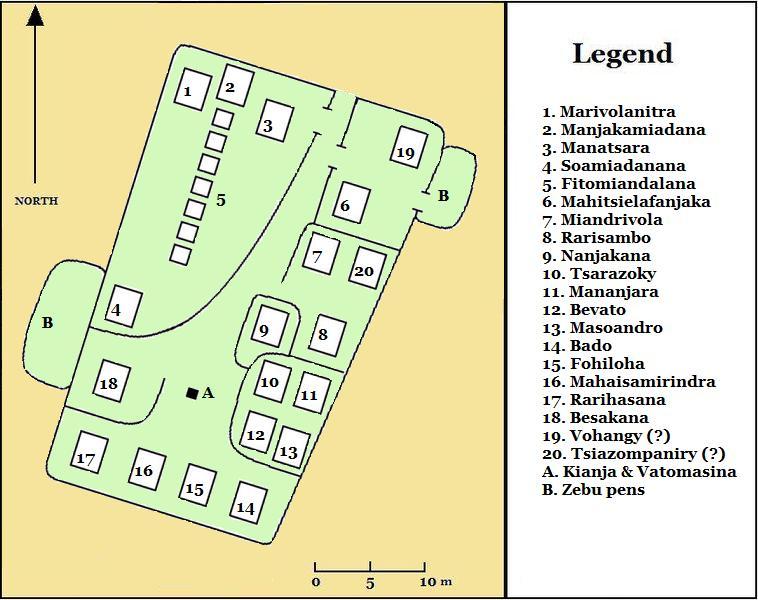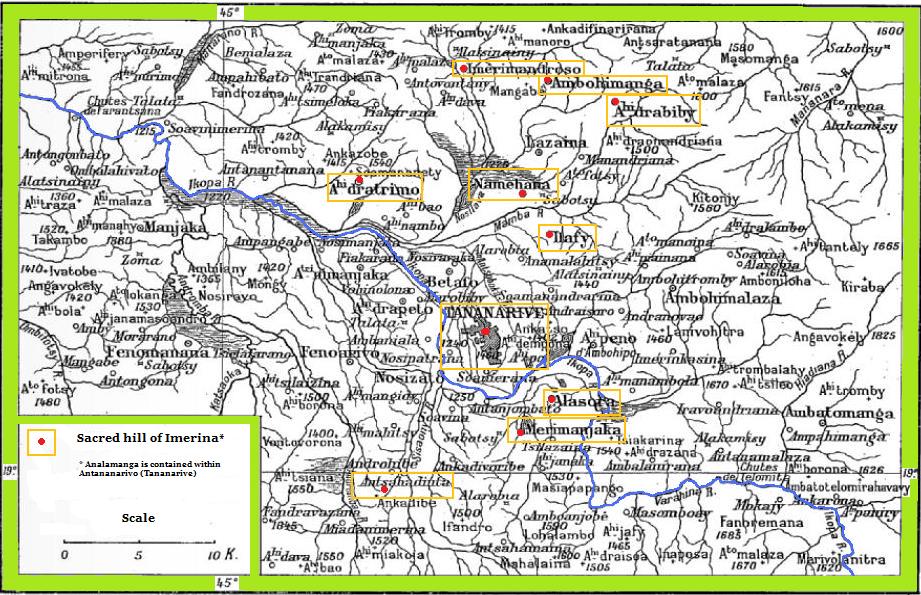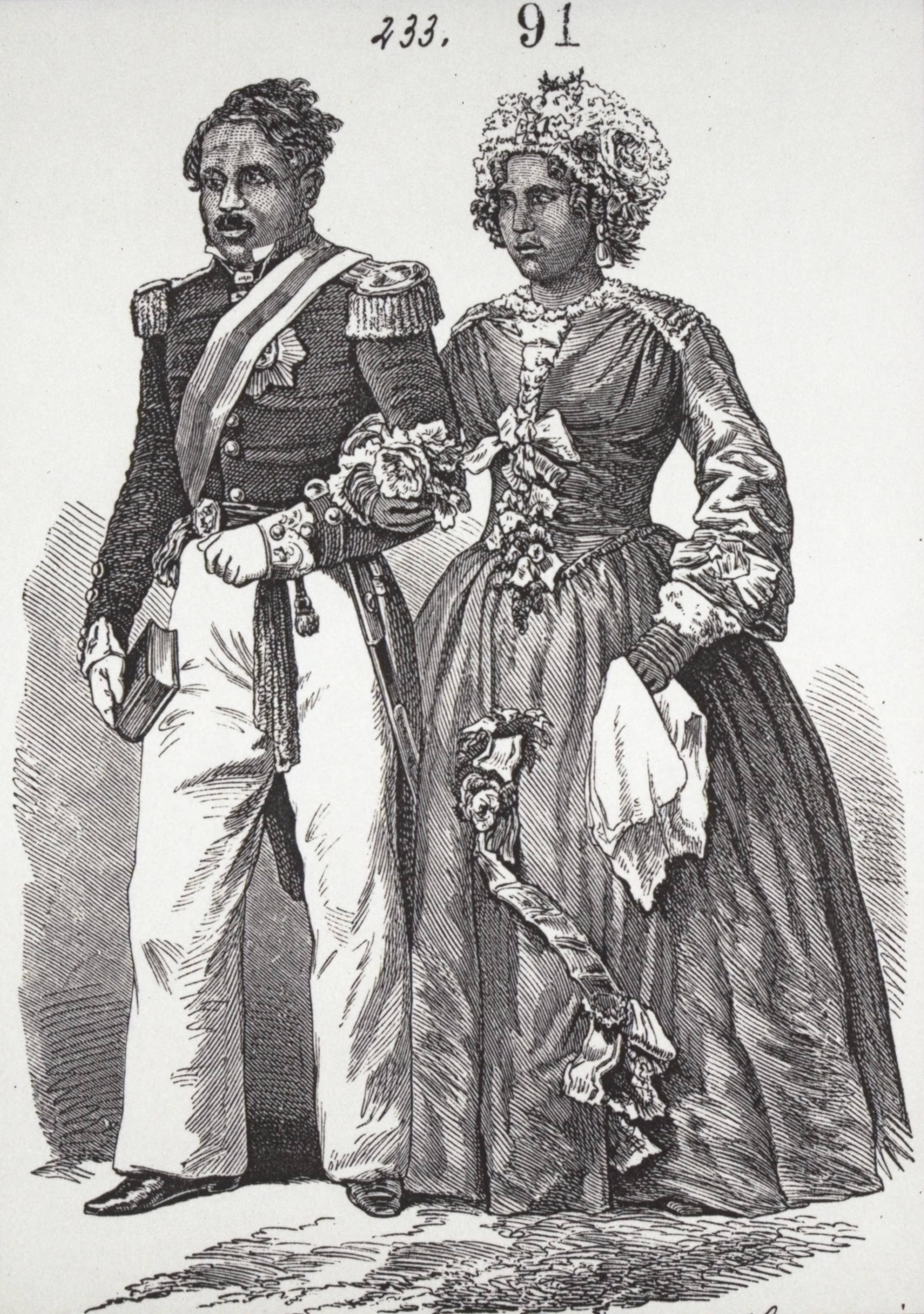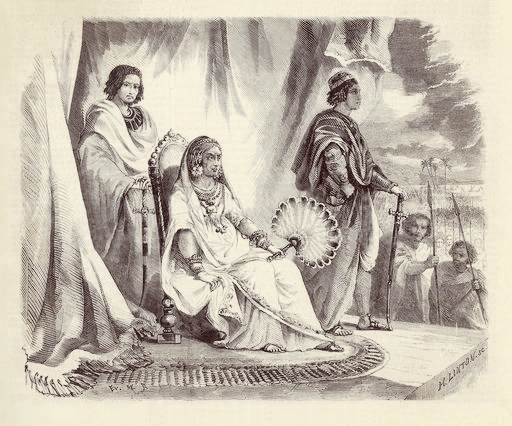|
Rova (Madagascar)
A rova is a fortified royal complex built in the central highlands of Madagascar by Merina of the ''Andriana'' (noble) class. The first rova was established at Alasora by king Andriamanelo around 1540 to protect his residence throughout a war with the neighboring Vazimba. Rovas are organized according to traditional symbolic notions of space and enclose the royal residences, the tomb of the founder, and a town square marked with a stone. They are protected with walls, trenches and stone gateways and are planted with fig trees symbolic of royalty. History By the 15th century the Merina ethnic group from the southeastern coast had gradually migrated into the central highlands where they established hilltop villages interspersed among existing Vazimba settlements ruled by local kings. King Andriamanelo (1540–1575), the son of Vazimba queen Rafohy and a man of the newly arrived Hova people originating in southeast Madagascar, ultimately led a series of military campaigns against ... [...More Info...] [...Related Items...] OR: [Wikipedia] [Google] [Baidu] |
Madagascar
Madagascar (; mg, Madagasikara, ), officially the Republic of Madagascar ( mg, Repoblikan'i Madagasikara, links=no, ; french: République de Madagascar), is an island country in the Indian Ocean, approximately off the coast of East Africa across the Mozambique Channel. At Madagascar is the world's second-largest island country, after Indonesia. The nation is home to around 30 million inhabitants and consists of the island of Madagascar (the fourth-largest island in the world), along with numerous smaller peripheral islands. Following the prehistoric breakup of the supercontinent Gondwana, Madagascar split from the Indian subcontinent around 90 million years ago, allowing native plants and animals to evolve in relative isolation. Consequently, Madagascar is a biodiversity hotspot; over 90% of its wildlife is endemic. Human settlement of Madagascar occurred during or before the mid first millennium AD by Austronesian peoples, presumably arriving on outrigger cano ... [...More Info...] [...Related Items...] OR: [Wikipedia] [Google] [Baidu] |
Rova Of Antananarivo
The Rova of Antananarivo ( mg, Rovan'i Manjakamiadana ) is a royal palace complex ('' rova'') in Madagascar that served as the home of the sovereigns of the Kingdom of Imerina in the 17th and 18th centuries, as well as of the rulers of the Kingdom of Madagascar in the 19th century. Its counterpart is the nearby fortified village of Ambohimanga, which served as the spiritual seat of the kingdom in contrast to the political significance of the Rova in the capital. Located in the central highland city of Antananarivo, the Rova occupies the highest point on Analamanga, formerly the highest of Antananarivo's many hills. Merina king Andrianjaka, who ruled Imerina from around 1610 until 1630, is believed to have captured Analamanga from a Vazimba king around 1610 or 1625 and erected the site's first fortified royal structure. Successive Merina kings continued to rule from the site until the fall of the monarchy in 1896, frequently restoring, modifying or adding royal structures within ... [...More Info...] [...Related Items...] OR: [Wikipedia] [Google] [Baidu] |
Buildings And Structures In Madagascar
A building, or edifice, is an enclosed structure with a roof and walls standing more or less permanently in one place, such as a house or factory (although there's also portable buildings). Buildings come in a variety of sizes, shapes, and functions, and have been adapted throughout history for a wide number of factors, from building materials available, to weather conditions, land prices, ground conditions, specific uses, prestige, and aesthetic reasons. To better understand the term ''building'' compare the list of nonbuilding structures. Buildings serve several societal needs – primarily as shelter from weather, security, living space, privacy, to store belongings, and to comfortably live and work. A building as a shelter represents a physical division of the human habitat (a place of comfort and safety) and the ''outside'' (a place that at times may be harsh and harmful). Ever since the first cave paintings, buildings have also become objects or canvasses of much artis ... [...More Info...] [...Related Items...] OR: [Wikipedia] [Google] [Baidu] |
History Of Madagascar
The history of Madagascar is distinguished clearly by the early isolation of the landmass from the ancient supercontinent containing Africa and India, and by the island's late colonization by human settlers from the Sunda islands (Malay Archipelago) and from East Africa. These two factors facilitated the evolution and survival of thousands of endemic plant and animal species, some of which have gone extinct or are currently threatened with extinction. Trade in the Indian Ocean at the time of first colonization of Madagascar was dominated by Indonesian ships, probably of Borobudur ship and K'un-lun po types. Over the past two thousand years the island has received waves of settlers of diverse origins including Austronesian, Bantu, Arab, South Asian, Chinese, and European. The majority of the population of Madagascar today is a mixture of Austronesian and Bantu settlers. Despite popular belief, there has been no genetic input from Arabs or Indians, although one tribe, the ... [...More Info...] [...Related Items...] OR: [Wikipedia] [Google] [Baidu] |
Ralambo
Ralambo was the ruler of the Kingdom of Imerina in the central Highlands region of Madagascar from 1575 to 1612. Ruling from Ambohidrabiby, Ralambo expanded the realm of his father, Andriamanelo, and was the first to assign the name of Imerina to the region. Oral history has preserved numerous legends about this king, including several dramatic military victories, contributing to his heroic and near-mythical status among the kings of ancient Imerina. The circumstances surrounding his birth, which occurred on the highly auspicious date of the first of the year, are said to be supernatural in nature and further add to the mystique of this sovereign. Oral history attributes numerous significant and lasting political and cultural innovations to King Ralambo. He is credited with popularizing the consumption of beef in the Kingdom of Imerina and celebrating this discovery with the establishment of the ''fandroana'' New Year's festival which traditionally took place on the day of Ral ... [...More Info...] [...Related Items...] OR: [Wikipedia] [Google] [Baidu] |
Twelve Sacred Hills Of Imerina
The twelve sacred hills of Imerina are hills of historical significance to the Merina people of Madagascar. Located throughout Imerina, the central area of the highlands of Madagascar, the sites were often ancient capitals, the birthplaces of key public figures, or the tomb sites of esteemed political or spiritual leaders. The first set of sacred sites was designated by early 17th-century king Andrianjaka. The notion was re-sanctified under late 18th-century king Andrianampoinimerina, who replaced several of the earlier sites with new ones. More than 12 sites were thus designated as sacred over time, although the notion of twelve sacred hills was perpetuated because of the significance of the number 12 in Malagasy cosmology. Today, little concrete evidence of the former importance of many of these sites remains, but the significant archeological and cultural heritage of several of the sites has been preserved. The historic significance of the sites is best represented by the ... [...More Info...] [...Related Items...] OR: [Wikipedia] [Google] [Baidu] |
Radama II
Radama II (September 23, 1829 – May 12, 1863 'contested'' was the son and heir of Queen Ranavalona I and ruled from 1861 to 1863 over the Kingdom of Madagascar, which controlled virtually the entire island. Radama's rule, although brief, was a pivotal period in the history of the Kingdom of Madagascar. Under the unyielding and often harsh 33-year rule of his mother, Queen Ranavalona I, Madagascar had successfully preserved its cultural and political independence from European colonial designs. Rejecting the queen's policy of isolationism and persecution of Christians, Radama II permitted religious freedom and re-opened Madagascar to European influence. Under the terms of the Lambert Charter, which Radama secretly contracted in 1855 with French entrepreneur Joseph-François Lambert while Ranavalona still ruled, the French were awarded exclusive rights to the exploitation of large tracts of valuable land and other lucrative resources and projects. This agreement, which was l ... [...More Info...] [...Related Items...] OR: [Wikipedia] [Google] [Baidu] |
Andrianjafy
King Andrianjafy (before -1787) also known as Andrianjafinandriamanitra and Andrianjafinjanahary, was the king of Imerina Avaradrano, the northern part of the central highlands of Madagascar with its capital at Ambohimanga. His father Andriambelomasina bequeathed him the rule of Avaradrano while designating his nephew Ramboasalama to follow Andrianjafy in the order of succession. Andrianjafy did not accept this decree, instead preferring that his own son succeed him, and sought retribution against citizens of Avaradrano who acknowledged the latent authority of his nephew. In order to prevent Ramboasalama from rising to power, Andrianjafy devised a series of failed plans to kill his nephew. The king's ineffectiveness as a ruler and despotic behavior contributed to declining popularity among the people of Avaradrano. Popular support for Ramboasalama produced a coup d'état in which he replaced Andrianjafy as King Andrianampoinimerina. Andrianjafy fled to Ilafy, where he rallied an ... [...More Info...] [...Related Items...] OR: [Wikipedia] [Google] [Baidu] |
Ilafy
Ilafy is a town and commune ( mg, kaominina) in Madagascar. It belongs to the district of Ambatondrazaka, which is a part of Alaotra-Mangoro Region. The population of the commune was estimated to be approximately 13,000 in 2001 commune census. Primary and junior level secondary education are available in town. The majority 96% of the population of the commune are farmers, while an additional 1% receives their livelihood from raising livestock. The most important crop is rice, while other important products are cassava, sweet potatoes and bambara groundnut. Industry and services provide employment for 0.5% and 1.5% of the population, respectively. Additionally fishing employs 1% of the population. Ilafy is of historical and cultural significance, widely considered one of the twelve sacred hills of Imerina The twelve sacred hills of Imerina are hills of historical significance to the Merina people of Madagascar. Located throughout Imerina, the central area of the highlands of ... [...More Info...] [...Related Items...] OR: [Wikipedia] [Google] [Baidu] |
Ranavalona I
Ranavalona I (born Rabodoandrianampoinimerina (also called Ramavo); 1778 – 16 August 1861), also known as Ranavalo-Manjaka I and the “Mad Monarch of Madagascar” was sovereign of the Kingdom of Madagascar from 1828 to 1861. After positioning herself as queen following the death of her young husband, Radama I, Ranavalona pursued a policy of isolationism and self-sufficiency, reducing economic and political ties with European powers, repelling a French attack on the coastal town of Foulpointe, and taking vigorous measures to eradicate the small but growing Malagasy Christian movement initiated under Radama I by members of the London Missionary Society. She made heavy use of the traditional practice of '' fanompoana'' (forced labor as tax payment) to complete public works projects and develop a standing army of between 20,000 and 30,000 Merina soldiers, whom she deployed to pacify outlying regions of the island and further expand the realm. The combination of regular wa ... [...More Info...] [...Related Items...] OR: [Wikipedia] [Google] [Baidu] |
Tsinjoarivo, Ambatolampy
Tsinjoarivo is a rural municipality in Madagascar. It is located in the district of Ambatolampy, which is in the Vakinankaratra Region, and is alongside the Onive River. The population of the commune was estimated to be approximately 20,000 in 2001 commune census. It is situated at a distance of 45 km from Ambatolampy. 14 fokontany (villages) belong to this municipality. Primary and junior level secondary education are available in town. The majority 99% of the population of the commune are farmers. The most important crop is rice, while other important products are beans, maize, cassava and potatoes. Services provide employment for 1% of the population. Due to its outstanding universal cultural value, the city, along with its associated rova, was added onto the UNESCO Tentative List of World Heritage Sites in Madagascar on November 14, 1997, in the cultural category. Notable waterfalls are located along the Onive River on the southwest side of the town. [...More Info...] [...Related Items...] OR: [Wikipedia] [Google] [Baidu] |
World Heritage Site
A World Heritage Site is a landmark or area with legal protection by an international convention administered by the United Nations Educational, Scientific and Cultural Organization (UNESCO). World Heritage Sites are designated by UNESCO for having cultural, historical, scientific or other form of significance. The sites are judged to contain " cultural and natural heritage around the world considered to be of outstanding value to humanity". To be selected, a World Heritage Site must be a somehow unique landmark which is geographically and historically identifiable and has special cultural or physical significance. For example, World Heritage Sites might be ancient ruins or historical structures, buildings, cities, deserts, forests, islands, lakes, monuments, mountains, or wilderness areas. A World Heritage Site may signify a remarkable accomplishment of humanity, and serve as evidence of our intellectual history on the planet, or it might be a place of great natural beauty. ... [...More Info...] [...Related Items...] OR: [Wikipedia] [Google] [Baidu] |





